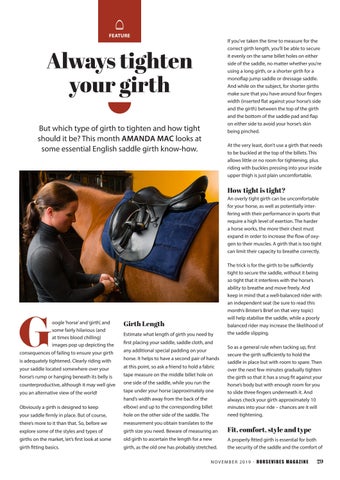FEATURE
If you’ve taken the time to measure for the correct girth length, you’ll be able to secure it evenly on the same billet holes on either side of the saddle, no matter whether you’re using a long girth, or a shorter girth for a monoflap jump saddle or dressage saddle. And while on the subject, for shorter girths make sure that you have around four fingers width (inserted flat against your horse’s side and the girth) between the top of the girth and the bottom of the saddle pad and flap on either side to avoid your horse’s skin being pinched.
Always tighten your girth But which type of girth to tighten and how tight should it be? This month AMANDA MAC looks at some essential English saddle girth know-how.
At the very least, don’t use a girth that needs to be buckled at the top of the billets. This allows little or no room for tightening, plus riding with buckles pressing into your inside upper thigh is just plain uncomfortable.
How tight is tight? An overly tight girth can be uncomfortable for your horse, as well as potentially interfering with their performance in sports that require a high level of exertion. The harder a horse works, the more their chest must expand in order to increase the flow of oxygen to their muscles. A girth that is too tight can limit their capacity to breathe correctly.
G
oogle ‘horse’ and ‘girth’, and some fairly hilarious (and at times blood chilling) images pop up depicting the
consequences of failing to ensure your girth is adequately tightened. Clearly riding with your saddle located somewhere over your horse’s rump or hanging beneath its belly is counterproductive, although it may well give
Girth Length Estimate what length of girth you need by first placing your saddle, saddle cloth, and any additional special padding on your horse. It helps to have a second pair of hands at this point, so ask a friend to hold a fabric tape measure on the middle billet hole on one side of the saddle, while you run the
you an alternative view of the world!
tape under your horse (approximately one
Obviously a girth is designed to keep
elbow) and up to the corresponding billet
your saddle firmly in place. But of course,
hole on the other side of the saddle. The
there’s more to it than that. So, before we
measurement you obtain translates to the
explore some of the styles and types of
girth size you need. Beware of measuring an
girths on the market, let’s first look at some
old girth to ascertain the length for a new
girth fitting basics.
girth, as the old one has probably stretched.
hand’s width away from the back of the
The trick is for the girth to be sufficiently tight to secure the saddle, without it being so tight that it interferes with the horse’s ability to breathe and move freely. And keep in mind that a well-balanced rider with an independent seat (be sure to read this month’s Brister’s Brief on that very topic) will help stabilise the saddle, while a poorly balanced rider may increase the likelihood of the saddle slipping. So as a general rule when tacking up, first secure the girth sufficiently to hold the saddle in place but with room to spare. Then over the next few minutes gradually tighten the girth so that it has a snug fit against your horse’s body but with enough room for you to slide three fingers underneath it. And always check your girth approximately 10 minutes into your ride – chances are it will need tightening.
Fit, comfort, style and type A properly fitted girth is essential for both the security of the saddle and the comfort of
NOVEMBER 2019 - HORSEVIBES MAGAZINE
29




















